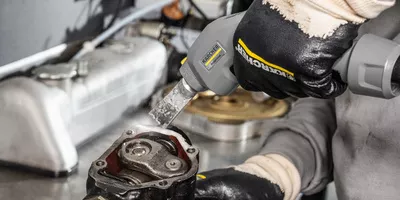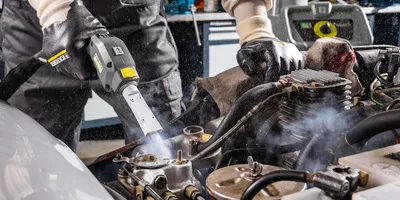Engine compartment, body or interior: Dry ice for cleaning delicate surfaces

Why Use Dry Ice?
Cleaning dirty car parts, tools and machines is usually hard work and often generates a lot of dirt. This is because methods like sandblasting leave behind spray agent, such as sand and glass granulate. Often, there is still cleaning to be done after cleaning the parts.
With this in mind, dry ice has a number of advantages for car workshops and conditioners: Above all, dry-ice blasting can be used without any issues in all applications where water is off-limits. This is particularly true of delicate vehicle electronics or when working on the bodywork of valuable vintage cars. This prevents potential damage to the delicate electronics caused by cleaning with water, protects parts against corrosive chemicals, protects mechanical tools and removes stubborn encrustations without leaving any residues.
Dry ice cleaning even provides a solution for tasks which were previously impossible or could only be accomplished while taking up a great deal of time. This method not only removes chewing gum residue and grease stains, it can also clean dashboards and inside engines immaculately.
It makes all areas clean
Dry-ice blasting can be used in a range of areas. Dry ice blasters can be used to remove varnishes and paints, oils, grease, tar, bitumen, ink, resin, adhesives, wax, silicone and rubber residues, chewing gum and a wide range of dirt coatings from different supporting materials. There are also options for removing old varnish from varnished surfaces layer by layer. Furthermore, this cleaning method has various areas of applications on vehicles.
Dry ice blasting in the engine compartment and on the body:
Metal Parts Rubber Parts Electronics
Engine, chassis, rims, sealing Hoses, handles, seals,
surfaces, thread, tools, exhaust brackets
lifting platforms
Dry ice cleaning in vehicle interiors:
Textiles and plastics inside and on vehicles: Seats, floor mats, roof liners, armrests, vents, dashboards, pedals










Comments